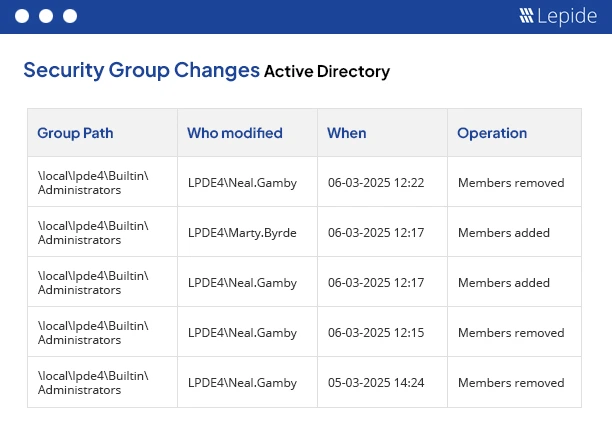According to Microsoft, 80% of observed attacks involve Active Directory (AD) or Entra ID. 50% of these attacks succeed because of common misconfigurations or poor AD hygiene. The reason? A fundamental lack of visibility into what’s happening in AD. That’s why proper, proactive, continuous Active Directory auditing is critical to preventing data breaches and maintaining compliance.
The Role of Active Directory Auditing in Modern IT Environments
Active Directory auditing is fundamental to risk management, organizational resilience, and regulatory compliance. Here are a few key roles that AD auditing plays:
- Security Enhancement: Active Directory auditing serves as an essential early warning mechanism. By monitoring login attempts, account changes, and privilege escalations in real time, it detects unauthorized access, privilege misuse, and insider threats. This helps identify these risks early on. The IT and security departments may be able to stop breaches because of this transparency, which provides them the time and chance to act quickly.
- Supports Incident Response: The most useful tools in the event of a security breach are audit logs. They enable incident responders to follow the course of malicious activity, detect sites of compromise, and piece together the chain of events. In-depth auditing makes it easier to identify the underlying reason, supports regulatory agencies in their investigations, and provides guidance for prompt recovery to lessen the severity of the damage or data loss.
- Enabling Regulatory Compliance: A highly regulated environment has emerged as a result of company growth. Organizations must abide by laws including GDPR, HIPAA, SOX, and PCI DSS and use the safest method possible to monitor user access and modifications. Active Directory auditing is a technique that records user actions in detail, including the time, date, and location. As a result, it is the technology that enables compliance obligations to be completed with ease of intervention and a minimal risk of fines.
- Driving Operational Efficiency: Regular Active Directory auditing is another way to find potential configuration vulnerabilities, permission creep, and unnecessary privileges that may have emerged recently or been left over. Resolving these problems not only improves the efficiency of IT operations but also reduces the attack surface of the company and ensures that users’ access rights are limited to what they require. As a result, productivity and the system’s overall resilience are increased.
- Preventing Insider Threats: One of the most challenging dangers the company faces is insider threats brought on by negligence. Organizations can monitor changes in privileged accounts, group memberships, and permissions at a high level through Active Directory auditing, which makes it much harder for insiders to operate covertly and gives security teams the chance to take early action.
- Review and Analysis: Continuous auditing helps businesses identify patterns, strengthen control system security, and enhance decision-making by compiling a historical data collection of all notable events and changes. Trend reports offer context for changes in user behavior and access patterns and assist in identifying dangers that have remained constant over time.
How AD Auditing Strengthens Cyber Defense
Active Directory (AD) auditing enables IT teams to track and analyze activity in the primary location for managing user permissions, access, and authentication. Auditing gives security teams visibility over unusual and potentially harmful user activities like privilege escalation, unusual logins, or incorrect access to sensitive data.
Active Directory auditing is crucial when recording and reporting adherence to internal security rules and regulatory standards. When investigating security issues and putting security measures in place, audit trails function as forensic evidence. Identifying outdated accounts, illegal modifications, and misconfigurations helps to reduce the likelihood of attacks and guarantee that the least privilege rule is adhered to. AD auditing also enables improved proactive threat identification and quicker reaction times when paired with central management and automatic alerting.
How AD Auditing Helps Meet Compliance
Active Directory (AD) auditing is crucial for meeting compliance requirements because of the following reason:
- Identifies vulnerabilities: First and foremost, routine audits can assist the company in identifying areas of the system that are improperly set or that have too many permissions, thus preventing the company from being hacked.
- Records Changes: It creates the historical account of every update, including group membership, policy modifications, and user account changes. Because of this, auditors are able to examine the change history and verify that the modifications were made with authorization.
- Monitors Data access: Conversely, auditing is the process of recording information concerning sensitive information access and identifying which laws, such HIPAA for health information, require strict access control.
- Proves Security Policy Compliance: One of the primary goals of audit logs is to provide concrete evidence that the company in question is following a corporate security policy and its particular protocols, which is an essential requirement under numerous legislation.
- Facilitates incident response and investigation: When there has been a security breach, audit trails give all the necessary information that helps the security team to figure out what caused the problem and understand the whole extent of the intrusion. This, in turn, is very important for linking up with post-breach reporting requirements.
How to Integrate AD Auditing Into a Holistic Security Strategy
Integrating Active Directory(AD) auditing as part of a holistic security strategy requires a multi-layered approach. The main steps are as follows:
- Establish a strong policy for AD focusing on the situations that matters most, eg – activities of user accounts, changes in the group membership, modifications in permissions, GPO changes, logon events, as well as configuration changes. Such occurrence gives a “key” to the detection of unauthorized changes, privilege escalation and unusual access patterns.
- It’s necessary to standardize and unify all audit records that come from AD logs and other systems in a Security Information and Event Management (SIEM) platform or any centralized data repository. As a result, this makes it possible to correlate across systems, alert in real-time, and report efficiently. Therefore, it becomes quite easy to identify threats at their initial stage and take the appropriate response.
- By establishing security risks for entities that can be audited and controlled, the Active Directory (AD) audit data may be connected to the organization’s shared risk and compliance framework. Use standard risk repositories and aligned audit scopes to start addressing control deficiencies and to communicate risk consistently.
- For important AD events, such the addition of a new member to a privileged group or several unsuccessful logins, set up immediate notification. In addition, use automated responses to potential risks, such as blocking modifications to the most significant objects or removing accounts that engage in suspicious activity, to lessen the damage as soon as feasible.
- Strict access controls and regular backups protect audit logs from manipulation or erasure by hackers. Regularly review and modify audit procedures and alert rules to account for evolving risks and legal requirements.
- Implement a layered security approach with endpoint detection on domain controllers, network intrusion detection specifically for AD traffic, and deception methods to expose lateral movement and insider threats.
- Embed Active Directory auditing as part of a larger security strategy through its integration with vulnerability scanning, security policy enforcement, zero trust models, employee training, and continuous improvement cycles. Such a comprehensive approach makes sure that Active Directory auditing is not only compliant but also a first line of defense in cybersecurity.
Through these best practices, companies have in place a closely interconnected Active Directory auditing system that is part of a holistic security strategy and thus offers security, control, and agility.
What is the Business Value of AD Auditing
Companies benefit from proactive AD auditing through enhanced security, compliance with regulations, and measurable risk reduction.
- Security: Organizations can use Active Directory auditing to quickly identify suspicious activity, privilege escalation, and unauthorized access. Through early threat detection, insider risk mitigation, and the provision of forensic data required for efficient incident response, auditing transforms security from a reactive to a proactive posture. Businesses may avoid data breaches and insider threats that jeopardize sensitive data and network integrity by regularly monitoring changes to user accounts, security groups, and access rights.
- Regulatory Compliance: Active Directory (AD) auditing produces very detailed records about all activities of the directory which helps in the compliance with regulations such as GDPR, HIPAA, SOX, and PCI-DSS. It achieves the transition of compliance from a tedious manual job into an automated and reportable process. It also offers the written evidence required to comply with regulations and prevent the business from paying hefty fines. Because it speeds up security operations and audit readiness procedures, this results in significant labor cost savings, enhanced efficiency, and, in most circumstances, very strong ROI.
- Operational Transparency: One of the ways that comprehensive auditing benefits IT teams is by giving an insight into all the AD activities and thus changes can be quickly analyzed, troubleshooting can be carried out the faster way, and besides this, the adequate supervision required for strong IT governance and security or operational issues resolution can be attained. In addition, by providing forensic analysis, it helps incident response interact well with each other, and together accomplish the work of tracing back and figuring out the causes and effects of security events.
- Policy Enforcement and Change Management: The audit performs a role in the implementation of security policies that require the establishment of continuous monitoring by making changes to records that depict who did what, where, and when. By detecting unauthorized changes to directory items, it assists in upholding appropriate change management discipline and guarantees the security and dependability of the AD system.
- Risk Mitigation: Active Directory auditing, by recording every critical change and access event, is a great way to alleviate risks that arise from insider threats and errors in configuration that may be unintentional. The organizations will be able to apply the theory of least privilege, and at the same time, it will be possible to note the deviations quickly; thus potential damage caused due to human errors or malicious insiders will be minimal.
Conclusion
Active Directory (AD) auditing should be at the core of an organization’s IT security and compliance strategy. By auditing, entities can identify threats, implement access controls, and comply with regulations as they get a clear view of every move made in an AD environment. Ultimately, Active Directory auditing is a vital resource in the current risk-conscious, compliance-driven business environment, as it not only ensures that companies can audit with confidence and demonstrate good governance, along with safeguarding sensitive assets and breach prevention.
How Does Lepide Help?
Lepide offers an all-inclusive Active Directory auditing solution that is intended to improve enterprises’ security and compliance. The platform gives IT teams comprehensive audit trails of user activity, permissions, and group policy modifications by providing real-time monitoring, tracking, and reporting of all AD changes. Early identification of illegitimate access, privilege escalation, or other suspicious behaviors is made possible by automated warnings and pre-configured reports.
Lepide’s intuitive dashboard speeds up issue response and investigation time by turning complicated audit logs into useful information. By providing ready-made audit reports, expediting compliance efforts, and simplifying the process of gathering evidence for auditors, the solution also complies with regulatory standards (GDPR, HIPAA, SOX, etc.).
Boost Active Directory auditing to strengthen your security. Get a free trial or schedule a demo with one of our engineers to see how Lepide can help you improve Active Directory auditing right now.



